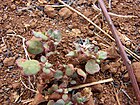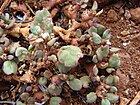Note: This is a project under development. The articles on this wiki are just being initiated and broadly incomplete. You can Help creating new pages.
Difference between revisions of "Trianthema portulacastrum"
(Created page with "{{stub}} ==Uses== {{Uses|}}, {{Uses|}}, {{Uses|}}, {{Uses|}}, {{Uses|}}, {{Uses|}}, {{Uses|}}, {{Uses|}}, {{Uses|}}, {{Uses|}}, {{Uses|}}.<ref name="Uses"/> ==Parts Used== {{...") |
|||
| Line 1: | Line 1: | ||
| − | + | [[File:Trianthema portulacastrum1.jpg|thumb|right|''Trianthema portulacastrum'']] | |
| + | '''Horse purslane''' is an annual, succulent, prostrate or ascending herb, often much-branched, growing up to about 60 cm tall, with a firm taproot. The plant is harvested from the wild for local use. It has a number of medicinal virtues and is sometimes also eaten, though there are conflicting reports on the wisdom of this. The dried plants are sometimes traded for their medicinal qualities. | ||
==Uses== | ==Uses== | ||
| − | {{Uses|}}, {{Uses|}}, {{Uses|}}, {{Uses|}}, {{Uses|}}, {{Uses|}}, {{Uses|}}, {{Uses|}}, {{Uses|}}, {{Uses|}}, {{Uses|}}.<ref name="Uses"/> | + | {{Uses|Asthma}}, {{Uses|Amenorrhoea}}, {{Uses|Venereal discharge}}, {{Uses|Oedema}}, {{Uses|Jaundice}}, {{Uses|Strangury}}, {{Uses|Dropsy}}, {{Uses|Gonorrhoea}}, {{Uses|Rheumatism}}, {{Uses|}}, {{Uses|}}.<ref name="Uses"/> |
==Parts Used== | ==Parts Used== | ||
| − | {{Parts Used| | + | {{Parts Used|Leaves}}. |
==Chemical Composition== | ==Chemical Composition== | ||
| Line 10: | Line 11: | ||
==Common names== | ==Common names== | ||
| − | {{Common names|sa=|en=|gu=|hi=|kn=|ks=|ml=|mr=|pa=|ta=|te=}} | + | {{Common names|sa=Chiratika, Dhanapatra|en=Desert Horse Purslane, Giant pigweed|gu=|hi=Sabuni, Salsabuni|kn=Muchchugoni, Bili komme|ks=|ml=Talutama|mr=Pundhari-ghentuli|pa=|ta=Sharunnai, Shavalai|te=Ambatimadu, Galijeru}}<ref name="Common names"/> |
==Properties== | ==Properties== | ||
| Line 16: | Line 17: | ||
===Dravya=== | ===Dravya=== | ||
===Rasa=== | ===Rasa=== | ||
| − | |||
===Guna=== | ===Guna=== | ||
| Line 29: | Line 29: | ||
==Habit== | ==Habit== | ||
| − | {{Habit|}} | + | {{Habit|Annual}} |
==Identification== | ==Identification== | ||
| Line 48: | Line 48: | ||
==Mode of Propagation== | ==Mode of Propagation== | ||
| − | {{Propagation|}} | + | {{Propagation|Seeds}} |
==How to plant/cultivate== | ==How to plant/cultivate== | ||
| − | <ref name="How to plant/cultivate"/> | + | The plant has escaped from cultivation and become an aggressive weed in many parts of the tropics.<ref name="How to plant/cultivate"/> |
==Commonly seen growing in areas== | ==Commonly seen growing in areas== | ||
| − | {{Commonly seen|}}, {{Commonly seen|}}, {{Commonly seen|}}, {{Commonly seen|}}, {{Commonly seen|}}. | + | {{Commonly seen|Wastelands}}, {{Commonly seen|Roadsides}}, {{Commonly seen|Roadsides}}, {{Commonly seen|Cultivated crops}}, {{Commonly seen|Paddy fields}}. |
==Photo Gallery== | ==Photo Gallery== | ||
<gallery class="left" caption="" widths="140px" heights="140px"> | <gallery class="left" caption="" widths="140px" heights="140px"> | ||
| − | + | File:Trianthema portulacastrum1.jpg | |
| + | Image:Starr_050223-4345_Trianthema_portulacastrum.jpg | ||
| + | Image:Trianthema portulacastrum az.jpg|Arizona, USA | ||
| + | File:Starr 050223-4344 Trianthema portulacastrum.jpg | ||
| + | File:Starr 050722-2941 Trianthema portulacastrum.jpg | ||
| + | File:Starr 070221-4690 Trianthema portulacastrum.jpg | ||
| + | File:Starr 070221-4691 Trianthema portulacastrum.jpg | ||
| + | File:Starr 070221-4692 Trianthema portulacastrum.jpg | ||
| + | File:Starr 050223-4346 Trianthema portulacastrum.jpg|seedlings | ||
</gallery> | </gallery> | ||
| Line 64: | Line 72: | ||
<references> | <references> | ||
| − | <ref name="chemical composition">[ | + | <ref name="chemical composition">[Chemical constituents]</ref> |
| − | <ref name="Leaf">[ | + | <ref name="Leaf">[Morphology]</ref> |
| − | <ref name="How to plant/cultivate">[ | + | <ref name="Common names">[https://www.flowersofindia.net/catalog/slides/Desert%20Horse%20Purslane.html Common names]</ref> |
| + | |||
| + | <ref name="How to plant/cultivate">[http://tropical.theferns.info/viewtropical.php?id=Trianthema+portulacastrum Cultivation]</ref> | ||
<ref name="Uses">Indian Medicinal Plants by C.P.Khare</ref> | <ref name="Uses">Indian Medicinal Plants by C.P.Khare</ref> | ||
</references> | </references> | ||
==External Links== | ==External Links== | ||
| − | * [ ] | + | * [https://www.ncbi.nlm.nih.gov/pmc/articles/PMC3459455/ Trianthema portulacastrum on Ncbi.nlm.nih.gov] |
| − | + | ||
| − | + | ||
[[Category:Herbs]] | [[Category:Herbs]] | ||
Revision as of 12:47, 26 August 2020
Horse purslane is an annual, succulent, prostrate or ascending herb, often much-branched, growing up to about 60 cm tall, with a firm taproot. The plant is harvested from the wild for local use. It has a number of medicinal virtues and is sometimes also eaten, though there are conflicting reports on the wisdom of this. The dried plants are sometimes traded for their medicinal qualities.
Contents
- 1 Uses
- 2 Parts Used
- 3 Chemical Composition
- 4 Common names
- 5 Properties
- 6 Habit
- 7 Identification
- 8 List of Ayurvedic medicine in which the herb is used
- 9 Where to get the saplings
- 10 Mode of Propagation
- 11 How to plant/cultivate
- 12 Commonly seen growing in areas
- 13 Photo Gallery
- 14 References
- 15 External Links
Uses
Asthma, Amenorrhoea, Venereal discharge, Oedema, Jaundice, Strangury, Dropsy, Gonorrhoea, Rheumatism, [[:Category:Ayurvedic Herbs known to be helpful to treat |]], [[:Category:Ayurvedic Herbs known to be helpful to treat |]].[1]
Parts Used
Chemical Composition
Common names
| Language | Common name |
|---|---|
| Kannada | Muchchugoni, Bili komme |
| Hindi | Sabuni, Salsabuni |
| Malayalam | Talutama |
| Tamil | Sharunnai, Shavalai |
| Telugu | Ambatimadu, Galijeru |
| Marathi | Pundhari-ghentuli |
| Gujarathi | |
| Punjabi | |
| Kashmiri | |
| Sanskrit | Chiratika, Dhanapatra |
| English | Desert Horse Purslane, Giant pigweed |
Properties
Reference: Dravya - Substance, Rasa - Taste, Guna - Qualities, Veerya - Potency, Vipaka - Post-digesion effect, Karma - Pharmacological activity, Prabhava - Therepeutics.
Dravya
Rasa
Guna
Veerya
Vipaka
Karma
Prabhava
Habit
Identification
Leaf
| Kind | Shape | Feature |
|---|---|---|
Flower
| Type | Size | Color and composition | Stamen | More information |
|---|---|---|---|---|
| {{{5}}} |
Fruit
| Type | Size | Mass | Appearance | Seeds | More information |
|---|---|---|---|---|---|
Other features
List of Ayurvedic medicine in which the herb is used
Where to get the saplings
Mode of Propagation
How to plant/cultivate
The plant has escaped from cultivation and become an aggressive weed in many parts of the tropics.[5]
Commonly seen growing in areas
Wastelands, Roadsides, Roadsides, Cultivated crops, Paddy fields.
Photo Gallery
References
- ↑ Indian Medicinal Plants by C.P.Khare
- ↑ [Chemical constituents]
- ↑ Common names
- ↑ [Morphology]
- ↑ Cultivation
External Links
- Ayurvedic Herbs known to be helpful to treat Asthma
- Ayurvedic Herbs known to be helpful to treat Amenorrhoea
- Ayurvedic Herbs known to be helpful to treat Venereal discharge
- Ayurvedic Herbs known to be helpful to treat Oedema
- Ayurvedic Herbs known to be helpful to treat Jaundice
- Ayurvedic Herbs known to be helpful to treat Strangury
- Ayurvedic Herbs known to be helpful to treat Dropsy
- Ayurvedic Herbs known to be helpful to treat Gonorrhoea
- Ayurvedic Herbs known to be helpful to treat Rheumatism
- Ayurvedic Herbs known to be helpful to treat
- Herbs with Leaves used in medicine
- Herbs with common name in Kannada
- Herbs with common name in Hindi
- Herbs with common name in Malayalam
- Herbs with common name in Tamil
- Herbs with common name in Telugu
- Herbs with common name in Marathi
- Herbs with common name in Sanskrit
- Herbs with common name in English
- Habit - Annual
- Index of Plants which can be propagated by Seeds
- Herbs that are commonly seen in the region of Wastelands
- Herbs that are commonly seen in the region of Roadsides
- Herbs that are commonly seen in the region of Cultivated crops
- Herbs that are commonly seen in the region of Paddy fields
- Herbs









